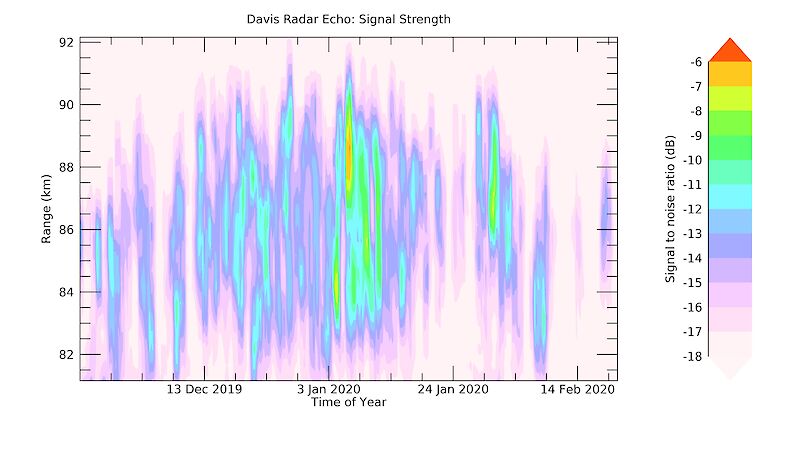Polar Mesosphere Summer Echoes (PMSE) are a sign of something peculiar about the polar atmosphere. They occur in the mesopause, about 85 km above Earth’s surface, in very low temperatures (about –130°C). The ice crystals present at these heights slow down the movement of electrons. This makes any disturbance in the motion of the air an excellent reflector of radio pulses. The radar echoes provide way to observe this strangely cold part of our atmosphere.
These low temperatures only occur in summer, when the polar atmosphere is bathed in sunlight. How is this possible? One theory is that, as air moves up toward the mesopause, it expands and cools as its thermal energy shares itself over a bigger volume. This cooling more than counteracts the warming effect of the sun. In this theory, the upward motion is driven by poleward movement of air in the mesosphere (the atmospheric level just below the mesopause) on a planetary scale. In Antarctica, these southward winds come together at the pole with nowhere else to go but up.
Persistent, large-scale southward winds are not easy to generate. The temperature gradients between the polar and lower latitudes will only make winds that blow east or west. But if this east-west flow slows down, the wind can blow southward all around the polar mesosphere. This slowing down is caused by waves.
Atmospheric gravity waves begin their life cycles in our near-ground weather systems. They travel up through the atmosphere and take some of our weather’s energy with them. They grow as they move upward and their energy is spread over the increasingly rarefied air. Many grow until they become unstable, breaking like waves on a beach. In breaking, they transfer their energy and momentum. This drives the circulation responsible for the cold summer mesopause.
To find out how these southward winds are sustained throughout the summer we need to know more about mesosphere-mesopause wind speeds. It is here that the atmospheric radars installed at Australia’s Davis research station comes into play. These radars work by sending out radio pulses and measuring the tiny signal reflected back to the ground by turbulent wind eddies common in this part of the atmosphere. By recording the motion of the eddies, the speed of the wind that carries them can be measured. In the seeming chaos of the winds at these heights, various physical phenomena can be identified, ranging from minute–to–minute turbulence to daily and sub-daily (12 and 8 hour) movements of the air known as tides. In between these time scales are the class of waves that hold the key to this puzzle.

